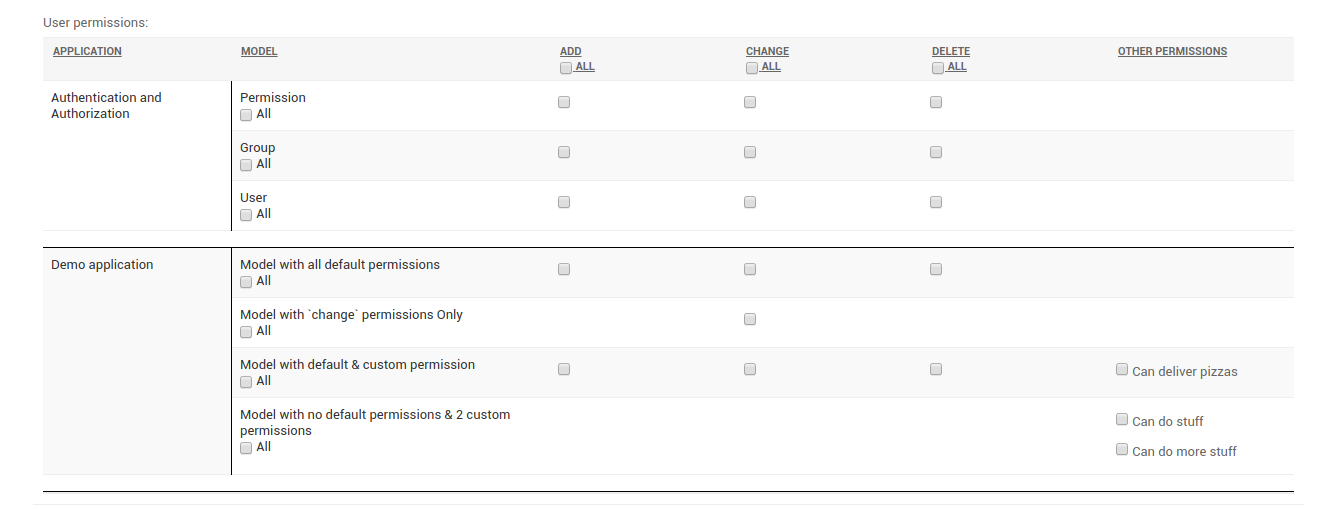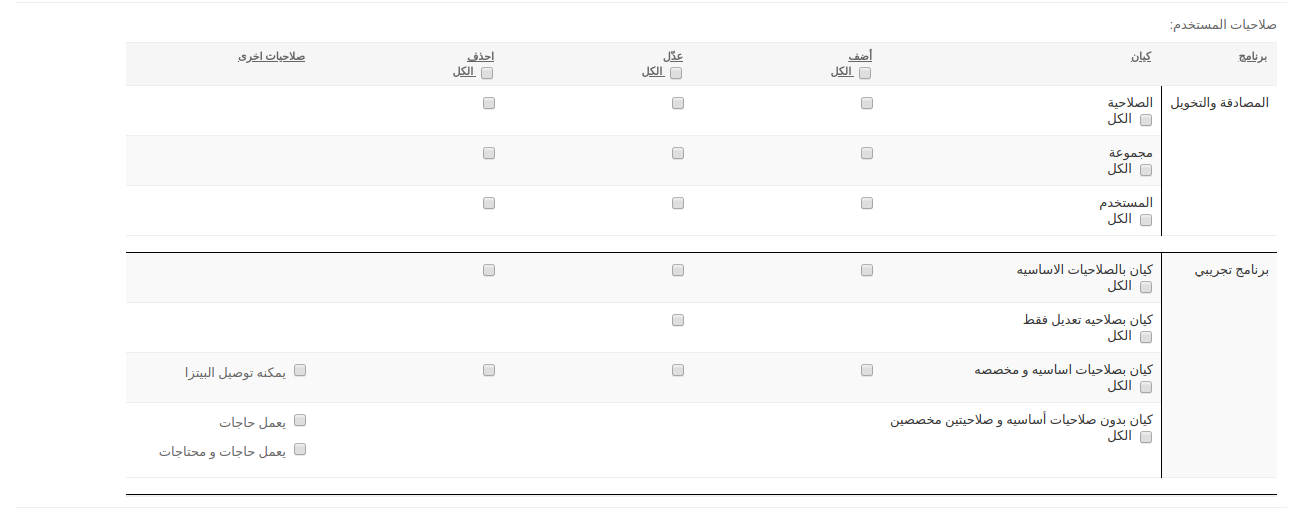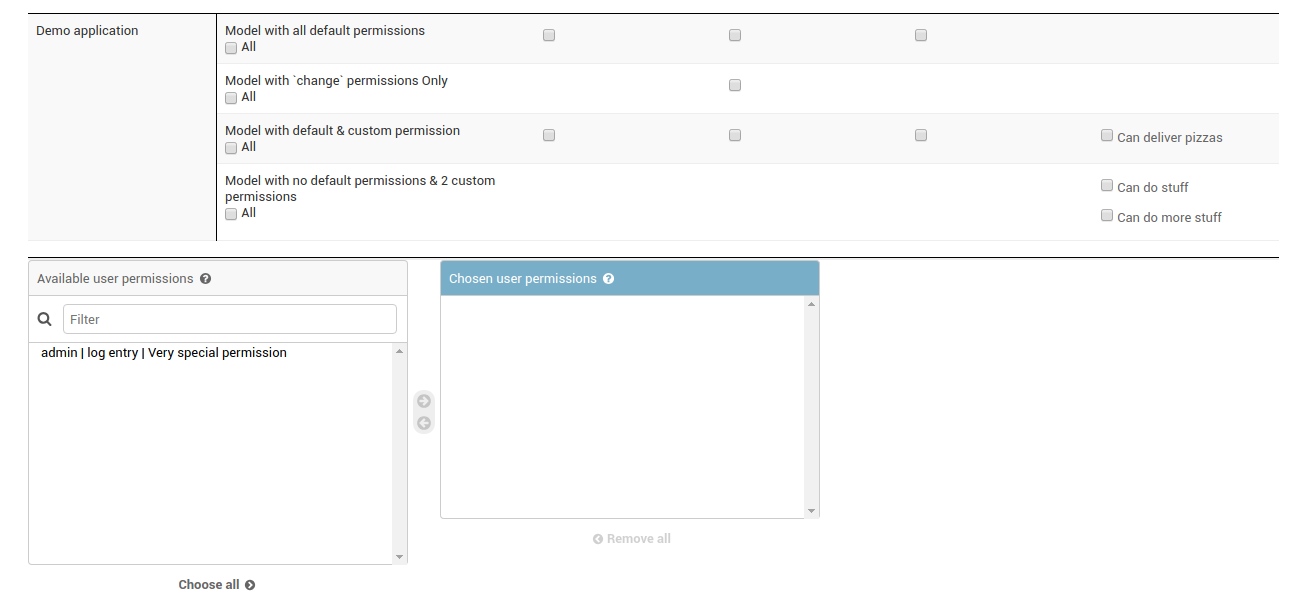Display django permissions in a tabular format that is user friendly, and highly customisable
Project description
Display model permissions in a tabular widget that is user friendly, translatable and customizeable.
Features:
Permissions and their relevant app and models names are displayed in the active language.
Permisions are displayed in a table that contain the default model permissions plus any custom permissions.
Customize which apps, models to show in the permissions table. You can also set a exclude function for high-end customization.
RTL ready, Bootstrap ready.
Easy customize-able look.
Django >= 1.11
Tested on Python 2.7, 3.5, 3.6 & 3.7
Default FilteredSelectMultiple widget will appear only if you have custom permissions that are not model related (ie directly created by code or hand)

Installation
You can install django-tabular-permissions via Pypi:
pip install django-tabular-permissions
and add “tabular_permissions” to your INSTALLED_APPS setting (at any place after django.contrib.auth)
INSTALLED_APPS = [
'django.contrib.auth',
....
'tabular_permissions',
]
then navigate to User and/or Group change form to see tabular_permissions in action.
Configuration:
Tabular_permissions possible configurations and their default:
TABULAR_PERMISSIONS_CONFIG = {
'template': 'tabular_permissions/admin/tabular_permissions.html',
'exclude': {
'override': False,
'app': [],
'model': [],
'function':'tabular_permissions.helpers.dummy_permissions_exclude'
},
'auto_implement': True,
'use_for_concrete': True,
'custom_permission_translation': 'tabular_permissions.helpers.custom_permissions_translator',
}
- template
the template which contains the permissions table, you can always customize this default by extending or overriding
- exclude
Control which apps, models to show in the permissions table.
By default tabular_permissions exclude sessions , contenttypes and admin apps from showing their models in the permissions table. If you want to show them you can switch override to False.
app & model lists would contain the names of the apps and models you wish to exclude.
function is a dotted path of a custom function which receive the model as a parameter to decide either to exclude it or not, default to a dummy function that always return False (ie do not exclude)
- auto_implement
By default, just by including tabular_permissions in your installed_apps, the django.contrib.admin.UserAdmin (and GroupAdmin) are “patched” to include the tabular_permissions widget. If you have a custom UserAdmin, then set this option to False and make sure you either:
Inherit from TabularPermissionsUserAdmin for User admin and from``TabularPermissionsGroupAdmin`` for group admin
Inherit from UserTabularPermissionsAdminBase and GroupTabularPermissionsAdminBase before admin.ModelAdmin for UserAdmin/GroupAdmin,
Set the user_permissions widget to tabular_permissions.widgets.TabularPermissionsWidget and remember to send a 3rd argument ‘permissions’ when in Group admin. See tabular_permissions.admin for information.
- use_for_concrete
There is an inconsistency with proxy models permissions (ticket 11154).
So in case you have proxy models and you create their permissions by hand (via this gist maybe), then turn off this option in order to correctly assign your newly created permissions in django-tabular-permissions widget.
- custom_permission_translation
a dotted path function to translate the custom permission. This function gets passed the permissions codename, verbose_name and its relevant content_type_id. The function will try to translate the permission verbose_name.
JavaScript:
Located at ‘static/tabular_permissions/tabular_permissions.js’, it have 2 responsibilities:
Upon form submit, the checked permissions in the table are dynamically appended to the form default permission input so the backend can carry on its functionality normally and correctly.
Add handlers for column and row select-all checkboxes.
Compatibility:
Current version 2.0 supports only django >= 1.11 For earlier versions of django use django-tabular-permissions 1.0.9.
Screenshots:
Basic Demo

RTL and localized

With Custom permission behaviour

Enjoy and feel free to report any bugs or make pull requests.cutom permissio
Project details
Release history Release notifications | RSS feed
Download files
Download the file for your platform. If you're not sure which to choose, learn more about installing packages.
Source Distribution
Hashes for django-tabular-permissions-2.0.tar.gz
| Algorithm | Hash digest | |
|---|---|---|
| SHA256 | ddccfe3ae5cb48e15dbea85c2b33ccfcfc9f446bbd8a991c5fca6a46b62f1e6c |
|
| MD5 | 4ccddf32fee04f18e1bf596878c87c85 |
|
| BLAKE2b-256 | a5262e86517f03836e9b5ff2f3769016f597bc90fe969f35768991c5fa2e5b08 |











